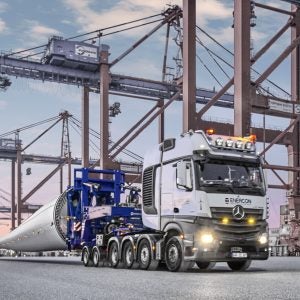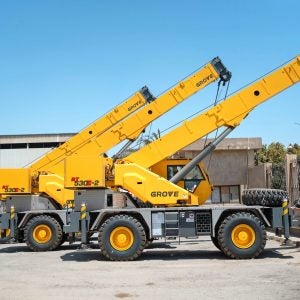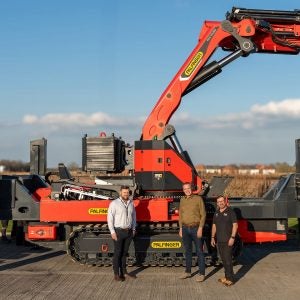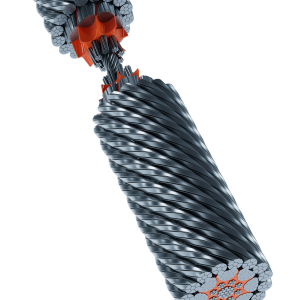
Link-Belt RTC 8090
Link-Belt has also launched the ATC-3250, a 250 US ton (220t) five-axle all-terrain crane, its third. The seven-section 223ft (68m) latching crane boom is powered by a single hydraulic cylinder. It locks at four places on each extension, providing a total of 38 different operational boom lengths. A 43ft (13.2) two-piece lattice fly and four 20ft (6m) lattice fly extensions further extend the crane’s maximum reach.
The crane also features Link-Belt’s LoadCom system that compensates for boom deflection by automatically hoisting the boom. In free swing mode, the operator can simply return the control lever to neutral or gradually reverse the direction of the swing control lever to bring the upper to a smooth stop. In automatic brake mode, the upper will automatically stop when the controller returns to the neutral position. Swing speed is 1.8 rpm. Hydraulic motors with final layer and third wrap indicators drive the main (front) and auxiliary (rear) winches. Maximum line pull for each winch is 24,504 lbs (11t) and the maximum line speed is 508 ft/min (155 m/min). A 530hp (390 kW) Mercedes-Benz engine and ZF AS-Tronic automated, 16-speed manual transmission deliver a top speed of 52.8 mph (85.0 km/hr). The crane features a 10x8x8 drive/steer configuration. The carrier also includes speed-dependent steering, hydro-pneumatic suspension, automatic levelling, ZF hydrodynamic driveline brake (intarder).
It has launched two crawlers: the 230 US ton (209t) capacity 298 HSL, and a 45 US ton (40t) capacity telescopic crawler crane, the TCC-450. The big crawler “provides the replacement answer for all the aging 230-ton crawlers in fleets around the world,” the company says, as well as fitting in between the company’s 200 US ton capacity 248 Hylab 5 and 300 US ton capacity 348 Hylab 5. It has 55,000 lbs (24 947.58 kg) of maximum line pull and a maximum line speed of 525 fpm (160.02 m/min).
The crane’s control system is a scaled-up version of the 218 HSL. Front and rear hoist drums are driven by variable displacement hydraulic piston motors that power the double planetary drive. Hoist and lowering control is further enhanced by hoist drums with adjustable speed control. Optional on the 298, is front and rear drum “freefall” using a new wet brake design. Power comes from a Mitsubishi Tier 3-approved 6m70-T3 365hp (272kW) engine. The crane has a 60ft-300ft (18m-91m) tubular lattice boom, and can also be fitted with optional 90ft (27m) fixed-angle jib. The main unit transports at 88,000 lbs (40t). The crawler also features a remote-controlled counterweight removal system.
The company has also launched a new ‘angle’ heavy boom design for the 218 HSL for field service work, clamshell, pile driving or other heavy-duty work. The boom has 4 in x 4 in x .5 in chords and is available in lengths from 45ft to 155ft (14m-47m). It uses the same boom sections as the 308 Hylab 5.
The smaller crawler, the TCC-450, is a North American version of the SCX400T, the 40t telescopic crawler launched in Europe in 2005 by sister company Hitachi Construction Machinery (Europe). The TCC-450 features a 33ft–105ft (10–32m) 4-section, box boom. It gets 11,000 lbs (5t) of line pull from the main winch. A 197-hp (147 kW) Isuzu engine provides Tier 3-compliant power. Telescopic crawler cranes are prevalent in power line, ski lift, and water tank construction as well as right-of-way, foundation, and “tieback” work, the company said. “As this work becomes even more specialised, and general contractors look to TCC’s as a lifting solution alternative, the larger dealers and national rental houses will move toward adding these units to their fleets,” said Pat Collins, lattice crane product manager. “It’s conceivable we could expand to three or four different sized units.”
The US market has shown good growth over the year to March 2006, according to partner company Hitachi-Sumitomo Heavy Industries Construction Crane. Link-Belt is owned by Sumitomo Heavy Industries, which formed a 50:50 joint venture with Hitachi Construction Machinery Co. Ltd., tp form Hitachi Sumitomo Heavy Industries Construction Crane, a few years ago.
“Regarding overseas markets, in North America, buoyant investment in housing and growth in oil drilling (extraction), as well as hurricane disaster recovery, combined to create substantial growth in the crane market compared to the previous year,” the company said in its annual report. It claims Link-Belt leads the crawler crane market with 40% market share.
Hitachi-Sumitomo reported net sales of 24.5bn Yen ($220m) and 1.3bn Yen ($11.3m) net income in the consolidated operating results of its year to March 31. In the report, it predicted consolidated net sales to grow 21% to 31bn Yen ($270m) in the year to 31 March 2007.






